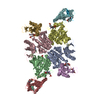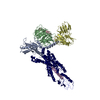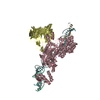+ Open data
Open data
- Basic information
Basic information
| Entry | Database: PDB / ID: 7rkf | |||||||||
|---|---|---|---|---|---|---|---|---|---|---|
| Title | Structure of CX3CL1-US28-G11iN18-scFv16 in TL-state | |||||||||
 Components Components |
| |||||||||
 Keywords Keywords |  MEMBRANE PROTEIN / Viral GPCR / MEMBRANE PROTEIN / Viral GPCR /  HCMV / HCMV /  cytomegalovirus / G protein complex / GDP-bound state cytomegalovirus / G protein complex / GDP-bound state | |||||||||
| Function / homology |  Function and homology information Function and homology informationpositive regulation by virus of host cell division / : / CXCR1 chemokine receptor binding / positive regulation of calcium-independent cell-cell adhesion / negative regulation of glutamate receptor signaling pathway / negative regulation of interleukin-1 alpha production / leukocyte adhesive activation / regulation of melanocyte differentiation /  CX3C chemokine receptor binding / negative regulation of hippocampal neuron apoptotic process ...positive regulation by virus of host cell division / : / CXCR1 chemokine receptor binding / positive regulation of calcium-independent cell-cell adhesion / negative regulation of glutamate receptor signaling pathway / negative regulation of interleukin-1 alpha production / leukocyte adhesive activation / regulation of melanocyte differentiation / CX3C chemokine receptor binding / negative regulation of hippocampal neuron apoptotic process ...positive regulation by virus of host cell division / : / CXCR1 chemokine receptor binding / positive regulation of calcium-independent cell-cell adhesion / negative regulation of glutamate receptor signaling pathway / negative regulation of interleukin-1 alpha production / leukocyte adhesive activation / regulation of melanocyte differentiation /  CX3C chemokine receptor binding / negative regulation of hippocampal neuron apoptotic process / CX3C chemokine receptor binding / negative regulation of hippocampal neuron apoptotic process /  autocrine signaling / synapse pruning / negative regulation of neuron migration / positive regulation of microglial cell migration / negative regulation of microglial cell activation / positive regulation of transforming growth factor beta1 production / Fatty Acids bound to GPR40 (FFAR1) regulate insulin secretion / regulation of lipopolysaccharide-mediated signaling pathway / Acetylcholine regulates insulin secretion / endothelin receptor signaling pathway / ion channel modulating, G protein-coupled receptor signaling pathway / phospholipase C-activating G protein-coupled acetylcholine receptor signaling pathway / developmental pigmentation / autocrine signaling / synapse pruning / negative regulation of neuron migration / positive regulation of microglial cell migration / negative regulation of microglial cell activation / positive regulation of transforming growth factor beta1 production / Fatty Acids bound to GPR40 (FFAR1) regulate insulin secretion / regulation of lipopolysaccharide-mediated signaling pathway / Acetylcholine regulates insulin secretion / endothelin receptor signaling pathway / ion channel modulating, G protein-coupled receptor signaling pathway / phospholipase C-activating G protein-coupled acetylcholine receptor signaling pathway / developmental pigmentation /  chemokine receptor activity / positive regulation of I-kappaB phosphorylation / cellular response to pH / microglial cell proliferation / positive regulation of actin filament bundle assembly / PLC beta mediated events / phospholipase C-activating dopamine receptor signaling pathway / cranial skeletal system development / CCR chemokine receptor binding / leukocyte migration involved in inflammatory response / entrainment of circadian clock / lymphocyte chemotaxis / chemokine receptor activity / positive regulation of I-kappaB phosphorylation / cellular response to pH / microglial cell proliferation / positive regulation of actin filament bundle assembly / PLC beta mediated events / phospholipase C-activating dopamine receptor signaling pathway / cranial skeletal system development / CCR chemokine receptor binding / leukocyte migration involved in inflammatory response / entrainment of circadian clock / lymphocyte chemotaxis /  phototransduction, visible light / integrin activation / eosinophil chemotaxis / angiogenesis involved in wound healing / chemokine-mediated signaling pathway / leukocyte chemotaxis / Chemokine receptors bind chemokines / phototransduction, visible light / integrin activation / eosinophil chemotaxis / angiogenesis involved in wound healing / chemokine-mediated signaling pathway / leukocyte chemotaxis / Chemokine receptors bind chemokines /  chemokine activity / negative regulation of cell-substrate adhesion / positive regulation of cell-matrix adhesion / negative regulation of interleukin-1 beta production / chemokine activity / negative regulation of cell-substrate adhesion / positive regulation of cell-matrix adhesion / negative regulation of interleukin-1 beta production /  action potential / neuron remodeling / positive regulation of neuroblast proliferation / positive chemotaxis / action potential / neuron remodeling / positive regulation of neuroblast proliferation / positive chemotaxis /  chemoattractant activity / ligand-gated ion channel signaling pathway / monocyte chemotaxis / negative regulation of interleukin-6 production / negative regulation of apoptotic signaling pathway / negative regulation of tumor necrosis factor production / photoreceptor outer segment / chemoattractant activity / ligand-gated ion channel signaling pathway / monocyte chemotaxis / negative regulation of interleukin-6 production / negative regulation of apoptotic signaling pathway / negative regulation of tumor necrosis factor production / photoreceptor outer segment /  regulation of neurogenesis / negative regulation of extrinsic apoptotic signaling pathway in absence of ligand / cellular response to interleukin-1 / enzyme regulator activity / extrinsic apoptotic signaling pathway in absence of ligand / virus-mediated perturbation of host defense response / cell chemotaxis / regulation of neurogenesis / negative regulation of extrinsic apoptotic signaling pathway in absence of ligand / cellular response to interleukin-1 / enzyme regulator activity / extrinsic apoptotic signaling pathway in absence of ligand / virus-mediated perturbation of host defense response / cell chemotaxis /  neutrophil chemotaxis / negative regulation of cell migration / G protein activity / positive regulation of release of sequestered calcium ion into cytosol / cell projection / neutrophil chemotaxis / negative regulation of cell migration / G protein activity / positive regulation of release of sequestered calcium ion into cytosol / cell projection /  skeletal system development / G protein-coupled receptor binding / response to ischemia / microglial cell activation / positive regulation of smooth muscle cell proliferation / skeletal system development / G protein-coupled receptor binding / response to ischemia / microglial cell activation / positive regulation of smooth muscle cell proliferation /  regulation of synaptic plasticity / G-protein beta/gamma-subunit complex binding / Olfactory Signaling Pathway / Activation of the phototransduction cascade / G beta:gamma signalling through PLC beta / Presynaptic function of Kainate receptors / Thromboxane signalling through TP receptor / adenylate cyclase-modulating G protein-coupled receptor signaling pathway / G-protein activation / defense response / G protein-coupled acetylcholine receptor signaling pathway / Activation of G protein gated Potassium channels / Inhibition of voltage gated Ca2+ channels via Gbeta/gamma subunits / Prostacyclin signalling through prostacyclin receptor / Glucagon signaling in metabolic regulation / G beta:gamma signalling through CDC42 / positive regulation of neuron projection development / ADP signalling through P2Y purinoceptor 12 / positive regulation of insulin secretion / regulation of synaptic plasticity / G-protein beta/gamma-subunit complex binding / Olfactory Signaling Pathway / Activation of the phototransduction cascade / G beta:gamma signalling through PLC beta / Presynaptic function of Kainate receptors / Thromboxane signalling through TP receptor / adenylate cyclase-modulating G protein-coupled receptor signaling pathway / G-protein activation / defense response / G protein-coupled acetylcholine receptor signaling pathway / Activation of G protein gated Potassium channels / Inhibition of voltage gated Ca2+ channels via Gbeta/gamma subunits / Prostacyclin signalling through prostacyclin receptor / Glucagon signaling in metabolic regulation / G beta:gamma signalling through CDC42 / positive regulation of neuron projection development / ADP signalling through P2Y purinoceptor 12 / positive regulation of insulin secretion /  cell-cell adhesion / G beta:gamma signalling through BTK / Sensory perception of sweet, bitter, and umami (glutamate) taste / Synthesis, secretion, and inactivation of Glucagon-like Peptide-1 (GLP-1) / photoreceptor disc membrane / Adrenaline,noradrenaline inhibits insulin secretion / Glucagon-type ligand receptors cell-cell adhesion / G beta:gamma signalling through BTK / Sensory perception of sweet, bitter, and umami (glutamate) taste / Synthesis, secretion, and inactivation of Glucagon-like Peptide-1 (GLP-1) / photoreceptor disc membrane / Adrenaline,noradrenaline inhibits insulin secretion / Glucagon-type ligand receptorsSimilarity search - Function | |||||||||
| Biological species |   Homo sapiens (human) Homo sapiens (human)  Mus musculus (house mouse) Mus musculus (house mouse)   Human cytomegalovirus Human cytomegalovirus | |||||||||
| Method |  ELECTRON MICROSCOPY / ELECTRON MICROSCOPY /  single particle reconstruction / single particle reconstruction /  cryo EM / Resolution: 4 Å cryo EM / Resolution: 4 Å | |||||||||
 Authors Authors | Tsutsumi, N. / Maeda, S. / Qu, Q. / Skiniotis, G. / Kobilka, B.K. / Garcia, K.C. | |||||||||
| Funding support |  United States, 2items United States, 2items
| |||||||||
 Citation Citation |  Journal: Sci Adv / Year: 2022 Journal: Sci Adv / Year: 2022Title: Atypical structural snapshots of human cytomegalovirus GPCR interactions with host G proteins Authors: Tsutsumi, N. / Maeda, S. / Qu, Q. / Voegele, M. / Jude, K.M. / Suomivuori, C.M. / Panova, O. / Waghray, D. / Kato, H.E. / Velasco, A. / Dror, R.O. / Skiniotis, G. / Kobilka, B.K. / Garcia, K.C. | |||||||||
| History |
|
- Structure visualization
Structure visualization
| Movie |
 Movie viewer Movie viewer |
|---|---|
| Structure viewer | Molecule:  Molmil Molmil Jmol/JSmol Jmol/JSmol |
- Downloads & links
Downloads & links
- Download
Download
| PDBx/mmCIF format |  7rkf.cif.gz 7rkf.cif.gz | 247.8 KB | Display |  PDBx/mmCIF format PDBx/mmCIF format |
|---|---|---|---|---|
| PDB format |  pdb7rkf.ent.gz pdb7rkf.ent.gz | 199 KB | Display |  PDB format PDB format |
| PDBx/mmJSON format |  7rkf.json.gz 7rkf.json.gz | Tree view |  PDBx/mmJSON format PDBx/mmJSON format | |
| Others |  Other downloads Other downloads |
-Validation report
| Arichive directory |  https://data.pdbj.org/pub/pdb/validation_reports/rk/7rkf https://data.pdbj.org/pub/pdb/validation_reports/rk/7rkf ftp://data.pdbj.org/pub/pdb/validation_reports/rk/7rkf ftp://data.pdbj.org/pub/pdb/validation_reports/rk/7rkf | HTTPS FTP |
|---|
-Related structure data
| Related structure data |  24496MC  7rkmC  7rknC  7rkxC  7rkyC M: map data used to model this data C: citing same article ( |
|---|---|
| Similar structure data |
- Links
Links
- Assembly
Assembly
| Deposited unit | 
|
|---|---|
| 1 |
|
- Components
Components
-Guanine nucleotide-binding protein ... , 3 types, 3 molecules ABC
| #1: Protein | Mass: 41254.125 Da / Num. of mol.: 1 Source method: isolated from a genetically manipulated source Source: (gene. exp.)   Homo sapiens (human) / Gene: GNA11, GA11 / Production host: Homo sapiens (human) / Gene: GNA11, GA11 / Production host:   Trichoplusia ni (cabbage looper) / References: UniProt: P29992 Trichoplusia ni (cabbage looper) / References: UniProt: P29992 |
|---|---|
| #2: Protein | Mass: 37728.152 Da / Num. of mol.: 1 Source method: isolated from a genetically manipulated source Source: (gene. exp.)   Homo sapiens (human) / Gene: GNB1 / Production host: Homo sapiens (human) / Gene: GNB1 / Production host:   Trichoplusia ni (cabbage looper) / References: UniProt: P62873 Trichoplusia ni (cabbage looper) / References: UniProt: P62873 |
| #3: Protein | Mass: 7432.554 Da / Num. of mol.: 1 Source method: isolated from a genetically manipulated source Source: (gene. exp.)   Homo sapiens (human) / Gene: GNG2 / Production host: Homo sapiens (human) / Gene: GNG2 / Production host:   Trichoplusia ni (cabbage looper) / References: UniProt: P59768 Trichoplusia ni (cabbage looper) / References: UniProt: P59768 |
-Protein , 2 types, 2 molecules LR
| #5: Protein |  CX3CL1 / C-X3-C motif chemokine 1 / CX3C membrane-anchored chemokine / Neurotactin / Small-inducible cytokine D1 CX3CL1 / C-X3-C motif chemokine 1 / CX3C membrane-anchored chemokine / Neurotactin / Small-inducible cytokine D1Mass: 10013.487 Da / Num. of mol.: 1 / Fragment: UNP residues 25-101 Source method: isolated from a genetically manipulated source Source: (gene. exp.)   Homo sapiens (human) / Gene: CX3CL1, FKN, NTT, SCYD1, A-152E5.2 / Production host: Homo sapiens (human) / Gene: CX3CL1, FKN, NTT, SCYD1, A-152E5.2 / Production host:   Homo sapiens (human) / References: UniProt: P78423 Homo sapiens (human) / References: UniProt: P78423 |
|---|---|
| #6: Protein | Mass: 42041.098 Da / Num. of mol.: 1 Source method: isolated from a genetically manipulated source Source: (gene. exp.)    Human cytomegalovirus / Strain: AD169 / Gene: US28 / Production host: Human cytomegalovirus / Strain: AD169 / Gene: US28 / Production host:   Homo sapiens (human) / References: UniProt: P69332 Homo sapiens (human) / References: UniProt: P69332 |
-Antibody / Non-polymers / Sugars , 3 types, 3 molecules D



| #4: Antibody | Mass: 27340.482 Da / Num. of mol.: 1 Source method: isolated from a genetically manipulated source Source: (gene. exp.)   Mus musculus (house mouse) / Production host: Mus musculus (house mouse) / Production host:   Trichoplusia ni (cabbage looper) Trichoplusia ni (cabbage looper) |
|---|---|
| #7: Chemical | ChemComp-GDP /  Guanosine diphosphate Guanosine diphosphate |
| #8: Sugar | ChemComp-NAG /  N-Acetylglucosamine N-Acetylglucosamine |
-Details
| Has ligand of interest | Y |
|---|
-Experimental details
-Experiment
| Experiment | Method:  ELECTRON MICROSCOPY ELECTRON MICROSCOPY |
|---|---|
| EM experiment | Aggregation state: PARTICLE / 3D reconstruction method:  single particle reconstruction single particle reconstruction |
- Sample preparation
Sample preparation
| Component |
| ||||||||||||||||||||||||||||||
|---|---|---|---|---|---|---|---|---|---|---|---|---|---|---|---|---|---|---|---|---|---|---|---|---|---|---|---|---|---|---|---|
| Molecular weight |
| ||||||||||||||||||||||||||||||
| Source (natural) |
| ||||||||||||||||||||||||||||||
| Source (recombinant) |
| ||||||||||||||||||||||||||||||
| Buffer solution | pH: 7.2 | ||||||||||||||||||||||||||||||
| Buffer component |
| ||||||||||||||||||||||||||||||
| Specimen | Conc.: 25 mg/ml / Embedding applied: NO / Shadowing applied: NO / Staining applied : NO / Vitrification applied : NO / Vitrification applied : YES : YES | ||||||||||||||||||||||||||||||
| Specimen support | Grid material: GOLD / Grid mesh size: 200 divisions/in. / Grid type: Quantifoil R1.2/1.3 | ||||||||||||||||||||||||||||||
Vitrification | Instrument: FEI VITROBOT MARK IV / Cryogen name: ETHANE / Humidity: 100 % / Chamber temperature: 295 K / Details: 1 s blotting before plunging |
- Electron microscopy imaging
Electron microscopy imaging
| Experimental equipment |  Model: Titan Krios / Image courtesy: FEI Company |
|---|---|
| Microscopy | Model: FEI TITAN KRIOS |
| Electron gun | Electron source : :  FIELD EMISSION GUN / Accelerating voltage: 300 kV / Illumination mode: FLOOD BEAM FIELD EMISSION GUN / Accelerating voltage: 300 kV / Illumination mode: FLOOD BEAM |
| Electron lens | Mode: BRIGHT FIELD Bright-field microscopy / Nominal magnification: 29000 X / Calibrated magnification: 58679 X / Nominal defocus max: -2000 nm / Nominal defocus min: -1000 nm / Cs Bright-field microscopy / Nominal magnification: 29000 X / Calibrated magnification: 58679 X / Nominal defocus max: -2000 nm / Nominal defocus min: -1000 nm / Cs : 2.7 mm / Alignment procedure: COMA FREE : 2.7 mm / Alignment procedure: COMA FREE |
| Specimen holder | Cryogen: NITROGEN / Specimen holder model: FEI TITAN KRIOS AUTOGRID HOLDER |
| Image recording | Electron dose: 67 e/Å2 / Detector mode: SUPER-RESOLUTION / Film or detector model: GATAN K3 (6k x 4k) / Num. of grids imaged: 1 / Num. of real images: 1330 |
- Processing
Processing
| Software | Name: PHENIX / Version: 1.19.2_4158: / Classification: refinement | ||||||||||||||||||||||||||||||||
|---|---|---|---|---|---|---|---|---|---|---|---|---|---|---|---|---|---|---|---|---|---|---|---|---|---|---|---|---|---|---|---|---|---|
| EM software |
| ||||||||||||||||||||||||||||||||
CTF correction | Details: Final per-particle CTF values were determined by Relion 3.1 CTF correction. Type: PHASE FLIPPING AND AMPLITUDE CORRECTION | ||||||||||||||||||||||||||||||||
| Particle selection | Num. of particles selected: 795403 | ||||||||||||||||||||||||||||||||
3D reconstruction | Resolution: 4 Å / Resolution method: FSC 0.143 CUT-OFF / Num. of particles: 126645 / Symmetry type: POINT | ||||||||||||||||||||||||||||||||
| Atomic model building | Protocol: FLEXIBLE FIT / Space: REAL | ||||||||||||||||||||||||||||||||
| Refine LS restraints |
|
 Movie
Movie Controller
Controller













 PDBj
PDBj

























